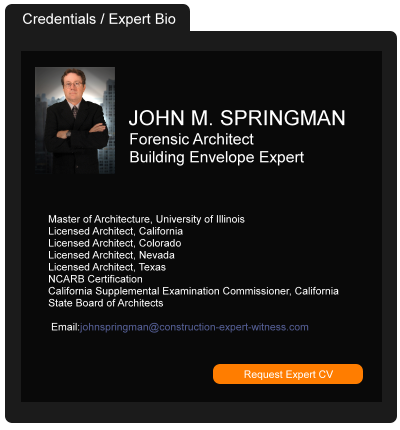When is Construction Put to Its “Intended Use”?
October 10, 2013 —
Brady Iandiorio — Higgins, Hopkins, McLain & Roswell, LLC.Defining words and phrases in the law can be a tricky proposition. In everyday life one would presume to know what the phrase “intended use” would mean, but when it comes to litigation, oftentimes the definitions become much more nuanced.
On March 12, 2013, in the Bituminous Cas. Corp. v. Hartford Cas. Ins. Co. v. Canal Ins. Co., WL 950800 (D. Colo. 2013) case, Senior District Court Judge Wiley Y. Daniel denied Third-Party Defendant Canal Insurance Company’s (“Canal”) motion to dismiss Third-Party Plaintiff Hartford Casualty Insurance Company’s (“Hartford”) third-party complaint. The case arose out of a liability insurance coverage dispute related to an underlying construction defect lawsuit. In the construction defect suit, a plaintiff homeowner’s association brought a suit against a developer and a general contractor (“GC”) among others. While the underlying action was settled, a dispute remained between Bituminous Casualty Corporation, which insured the GC, and Hartford, which insured the developer.
Hartford asserted third-party claims against Canal seeking a declaration of Canal’s obligations and contribution in the event Hartford owed any defense or indemnity obligations to the GC. Hartford’s claims are based on the premise that Canal owed a duty to defend and/or indemnify the GC in the underlying action.
Read the court decisionRead the full story...Reprinted courtesy of
Brady IandiorioBrady Iandiorio can be contacted at
Iandiorio@hhmrlaw.com
Blueprint for Change: How the Construction Industry Should Respond to the FTC’s Ban on Noncompetes
May 13, 2024 —
Matthew DeVries - Best Practices Construction LawIn a groundbreaking move aimed at fostering fair competition and empowering workers, the Federal Trade Commission (FTC) issued a final rule last week to ban noncompete agreements nationwide. This ruling may carry profound implications for the construction industry, prompting construction businesses to reassess their practices and ensure compliance while maintaining competitiveness. Let’s explore how construction companies, large and small, can navigate this regulatory shift effectively.
Noncompete clauses have long been a staple in employment contracts within the construction sector, often used to protect proprietary information and retain skilled talent. However, the FTC’s ban on noncompetes demands a reevaluation of these practices. Employers must recognize the potential consequences of noncompliance, including legal repercussions and reputational damage, and take proactive steps to adapt to the new regulatory landscape.
Communications with Employees
The FTC rule requires employers to provide a form notice of non-enforcement to all present and former employees subject to an unexpired noncompete provisions. However, given the immediate legal challenges to the FTC’s rule and the fact that the 120-day compliance window has not yet begun, there is no reason to take immediate action or begin notifying employees. Instead, business owners should wait for at least 60 days before taking concrete action in response to the rule to see if any court temporarily enjoins the effectiveness of the rule.
Read the court decisionRead the full story...Reprinted courtesy of
Matthew DeVries, Burr & Forman LLPMr. DeVries may be contacted at
mdevries@burr.com
Construction Defect Litigation at San Diego’s Alicante Condominiums?
March 25, 2011 —
Alicante HOA WebsiteAccording to recent posts in the Alicante HOA website, construction experts and legal counsel have been retained. The HOA board has been informed that testing of a variety of the building’s components are underway or will begin in the near future.
�Read More...
Read the court decisionRead the full story...Reprinted courtesy of
Reaffirming the Importance of Appeal Deadlines Under the Contract Disputes Act
January 26, 2017 —
Chadd Reynolds – Autry, Hanrahan, Hall & Cook, LLPA recent United States Court of Federal Claims (“COFC”) decision emphasizes the importance of deadlines for appealing a contracting officer’s (“CO”) decision under the Contract Disputes Act (“CDA”). On July 22, 2016, the COFC granted the consolidation of two naval contract dispute appeals totaling nearly $12.4 million in response to Nova Group/Tutor-Saliba’s (“NTS”) motion to resolve two Requests for Equitable Adjustment (“REA”) in the same forum. See Nova Group/Tutor-Saliba v. United States, No. 15-885C, 2016 WL 4009886, at *5 (Fed. Cl. July 22, 2016). NTS’s motion before the COFC sought to transfer an appeal of a REA before the COFC to the Armed Services Board of Contract Appeals (“ASBCA”), where another appeal of a REA arising under the same contract was presently on appeal. The COFC rejected NTS’s appeal to transfer the REA to the ASBCA because NTS did not appeal the REA within the 90-day limit under the CDA. Instead, the COFC allowed NTS to transfer the REA before the ASBCA to the COFC because timeliness was not an issue.
Read the court decisionRead the full story...Reprinted courtesy of
Chadd Reynolds, Autry, Hanrahan, Hall & Cook, LLPMr. Reynolds may be contacted at
reynolds@ahclaw.com
Court of Federal Claims: Upstream Hurricane Harvey Case Will Proceed to Trial
July 02, 2018 —
Anthony B. Cavender - Gravel2Gavel Construction & Real Estate Law Blog On May 24, the U.S. Court of Federal Claims decided one of what may be many cases involving the terrible flooding wrought by Hurricane Harvey in the Houston, TX region. The Court of Federal Claims has divided thousands of pending claims into “upstream” and “downstream” categories, depending on whether the flooded properties were located upstream or downstream of two U.S. Army Corps of Engineers (Corps) flood control reservoirs that were constructed in the 1940s and 1950s. The case is In re Upstream Addicks and Barker (Texas) Flood-Control Reservoirs; however, the Court of Federal Claims’ order in this case applies to “all upstream cases.”
Read the court decisionRead the full story...Reprinted courtesy of
Anthony B. Cavender, Pillsbury Winthrop Shaw Pittman LLPMr. Cavender may be contacted at
anthony.cavender@pillsburylaw.com
Construction Defect Dispute Governed by Contract Disputes Act not yet Suited to being a "Suit"
June 25, 2019 —
William S. Bennett - Saxe Doernberger & Vita, P.C.The Southern District of California recently held that a series of demands for a general contractor to investigate and repair several construction defects at a U.S. Army facility did not constitute a “suit” within the meaning of the general contractor’s commercial general liability (“CGL”) policy.
In Harper Construction Co., Inc. v. Nat’l Union Fire Ins. Co. of Pittsburgh, Pa., the U.S. Government hired Harper Construction Company (“Harper”) to construct a U.S. Army training facility for the Patriot Missile System in Fort Sill, Oklahoma. No. 18-cv-00471-BAS-NLS (S.D. Cal. Mar. 28, 2019). During the project, Harper hired Harper Mechanical Contractors (“Harper Mechanical”), an independent company, as a subcontractor “to perform demolition, grading, and other work at the Project.”
After Harper completed the project, the government informed Harper of property damage at the project, “including, but not limited to, gypsum wallboard cracks and binding doors.” Harper attempted to repair the issues, but the problems continued. The issues were apparently the result of Harper Mechanical’s grading work. Subsequently, the government sent two letters requesting an investigation and asking Harper to “propose a plan to correct the issues.” As Harper undertook an investigation spanning multiple years, the government became increasingly frustrated with the delays. The government threatened to initiate “formal administrative recourse” and to demolish the project, forcing Harper to re-build from the ground up. It also sent Harper another letter requesting Harper submit a formal proposal to correct the issues.
Read the court decisionRead the full story...Reprinted courtesy of
William S. Bennett, Saxe Doernberger & Vita, P.C.Mr. Bennett may be contacted at
wsb@sdvlaw.com
Arizona Supreme Court Confirms a Prevailing Homeowner Can Recover Fees on Implied Warranty Claims
August 30, 2017 —
Rick Erickson - Snell & Wilmer Real Estate Litigation BlogOn August 9th, in Sirrah Enterprises, L.L.C. v. Wunderlich, the Arizona Supreme Court settled the question about recovery of attorneys’ fees after prevailing on implied warranty claims against a residential contractor. The simple answer is, yes, a homeowner who prevails on the merits can recover the fees they spent to prove that shoddy construction breached the implied warranty of workmanship and habitability. Why? Because, as Justice Timmer articulated, “[t]he implied warranty is a contract term.” Although implied, the warranty is legally part of the written agreement in which “a residential builder warrants that its work is performed in a workmanlike manner and that the structure is habitable.”
In other words, a claim based on the implied warranty not only arises out of the contract, the claim is actually based on a contract term. Since, in A.R.S. § 12-341.01, Arizona law provides for prevailing parties to recover their fees on claims “arising out of contract” and because the implied warranty is now viewed by the courts as a contract term, homeowners can recover their fees after successfully proving breach of the implied warranty.
Read the court decisionRead the full story...Reprinted courtesy of
Rick Erickson, Snell & WilmerMr Erickson may be contacted at
rerickson@swlaw.com
The Case For Designers Shouldering More Legal Responsibility
November 21, 2018 —
Richard Korman - Engineering News-RecordUjjval Vyas is dignified, articulate and persistent. In past years he earned a law degree and a PhD where his thesis concerned Philip Johnson and architectural modernism. He is a founder of a hydrogen energy company. He is also leading a crusade, largely by himself, advocating that designers should be held to a "clients come first" approach applied to other professionals—an idea that would burden engineers and architects with the weight of vastly increased legal liability. The reactions to his ideas in the past have ranged from scornful to sympathetic.
Read the court decisionRead the full story...Reprinted courtesy of
Richard Korman, ENRMr. Korman may be contacted at
kormanr@enr.com


































































